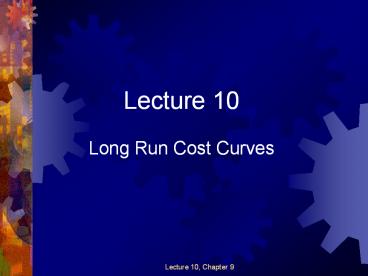Long Run Cost Curves - PowerPoint PPT Presentation
1 / 24
Title:
Long Run Cost Curves
Description:
In the last lecture we showed that the firm minimizes cost by equating the slope ... The third assumption makes sense: few firms are big enough to change wages. ... – PowerPoint PPT presentation
Number of Views:755
Avg rating:3.0/5.0
Title: Long Run Cost Curves
1
Lecture 10 Long Run Cost Curves
2
Cost Minimization in the Long Run
- In the last lecture we showed that the firm
minimizes cost by equating the slope of the
isoquant with the slope of the cost line - Figure 6 below shows the factor substitution
effect of a fall in the wage.
3
Chapter 9, Figure 6Effect of a Fall in the Wage
Rate on the Cost Minimum
4
The Firms Long Run Expansion Path
- Now consider cost minimization at different
outputs as in Figure 7 below. - The result of repeated cost minimization is a
one-to-one relationship between cost and outputa
cost function. - The total cost function is shown in Figure 8.
5
Chapter 9, Figure 7The Expansion Path and The
Long-Run Cost Curve (a)
6
Chapter 9, Figure 8The Expansion Path and The
Long-Run Cost Curve (b)
7
The Firms Long Run Expansion Path
- In deriving this total cost function three
assumptions are being made - 1) there are no fixed costs in the long run
- 2) output rises in the same proportion as labor
and capital inputs (constant returns). - 3) factor prices stay the same.
- The third assumption makes sense few firms are
big enough to change wages.
8
The Firms Long Run Expansion Path
- But the first assumption can be called into
question. Can a company avoid start-up costs? - The second assumption is debatable too what if
important inputs are held constant? - But if the assumptions hold you will get linear
total cost as shown in Figure 8.
9
A More General Analysis of Long Run Cost
- Figure 9 shows a more general situation, though
setup costs are still neglected in this figure. - As shown in the top panel total cost C at first
rises at a decreasing rate (some inputs are
underutilized at first), and then at a decreasing
rate (eventually, some inputs are strained to
capacity).
10
Chapter 9, Figure 9 Long-Run Cost Curves
11
A More General Analysis of Long Run Cost
- This means that average cost (AC) falls at first
and then increases. - In the lower panel of Figure 9 notice that
- When AC is falling, MC is below AC
- When AC is rising, MC is above AC
- When AC is at a minimum, MCAC
- Most efficient size occurs at q since AC equals
resource cost per unit produced.
12
A More General Analysis of Long Run Cost
- Each segment of the average cost curve in Figure
9 reflects a particular returns to scale. - Falling AC implies increasing returns to scale
- Rising AC implies decreasing returns to scale
- At the AC minimum constant returns to scale
applies
13
L-Shaped Average Cost
- In some industries fixed start-up costs generate
falling average cost or increasing returns to
scale. - This seems to be the case in the cement industry
see Figure 10. - Of course the data may stop just before AC turns
up, yielding part of the curve, which is then
L-shaped.
14
Chapter 9, Figure 10Average Cost of Cement Firms
15
Long Run and Short Run AC
- In the long run a firm chooses the plant size
(capital, K) that minimizes the total and average
cost of every output. - But K is fixed in the short run.
- The firm increases output in the short run by
moving along the flat expansion path in figure 11
using labor alone. - This is not cost-efficient in the long run.
16
Chapter 9, Figure 11Long-Run and
Short-Run Expansion Paths
17
Long Run and Short Run AC
- In the long run the firm can increase both
capital and labor, where the returns to scale are
more favorable. - Thus long run AC (LRAC) is less than or equal to
short run AC (SRAC) in figure 12. - LRAC is often called an envelope curve.
18
Chapter 9, Figure 12Long Run AC, the Envelope of
Short Run AC Curves
19
Examples of LRAC Curves
- The next two figures show examples of the long
run average cost curve. - The Norwegian printing firm has a flat or
constant returns LRAC in Figure 13. - The US oil pipeline example in Figure 14 shows
declining LRAC or increasing returns. Note how
the pipeline diameter increases with the
through-put of oil.
20
Chapter 9, Figure 13Long Run Cost Curves In A
Norwegian Printing Firm
21
Chapter 9, Figure 14Long-Run Cost Curves For US
Oil Pipelines
22
Learning by Doing
- One reason why costs are less in the long run is
learning by doing. - Definition
- Learning by doing refers to a decline in current
cost caused by an increase in past production. - Figure 15 illustrates this situation.
23
Chapter 9, Figure 15--Learning by Doing
24
Economies of Scope and Multiple Product Firms
- Sometimes its cheaper to produce goods together
than separately. - Definition
- An economy of scope (SC) occurs when
- Cockburn and Henderson (1996) found economies of
scope in drug research.































